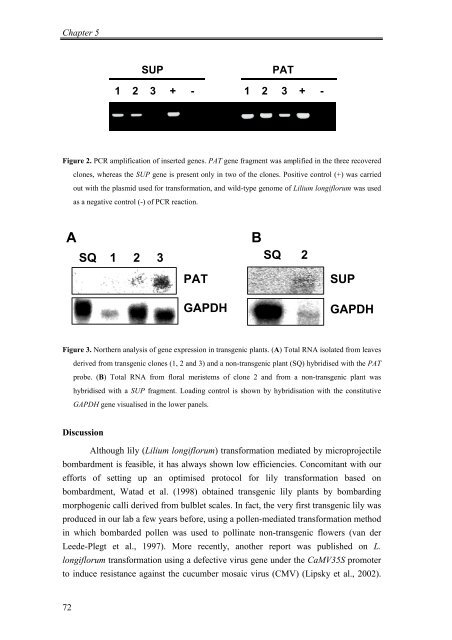Flower development of Lilium longiflorum - The Lilium information ...
Flower development of Lilium longiflorum - The Lilium information ...
Flower development of Lilium longiflorum - The Lilium information ...
You also want an ePaper? Increase the reach of your titles
YUMPU automatically turns print PDFs into web optimized ePapers that Google loves.
Chapter 5<br />
SUP PAT<br />
1 2 3 + - 1 2 3 + -<br />
Figure 2. PCR amplification <strong>of</strong> inserted genes. PAT gene fragment was amplified in the three recovered<br />
A<br />
clones, whereas the SUP gene is present only in two <strong>of</strong> the clones. Positive control (+) was carried<br />
out with the plasmid used for transformation, and wild-type genome <strong>of</strong> <strong>Lilium</strong> <strong>longiflorum</strong> was used<br />
as a negative control (-) <strong>of</strong> PCR reaction.<br />
SQ 1 2 3<br />
PAT<br />
GAPDH<br />
B<br />
SQ 2<br />
SUP<br />
GAPDH<br />
Figure 3. Northern analysis <strong>of</strong> gene expression in transgenic plants. (A) Total RNA isolated from leaves<br />
derived from transgenic clones (1, 2 and 3) and a non-transgenic plant (SQ) hybridised with the PAT<br />
probe. (B) Total RNA from floral meristems <strong>of</strong> clone 2 and from a non-transgenic plant was<br />
hybridised with a SUP fragment. Loading control is shown by hybridisation with the constitutive<br />
GAPDH gene visualised in the lower panels.<br />
Discussion<br />
Although lily (<strong>Lilium</strong> <strong>longiflorum</strong>) transformation mediated by microprojectile<br />
bombardment is feasible, it has always shown low efficiencies. Concomitant with our<br />
efforts <strong>of</strong> setting up an optimised protocol for lily transformation based on<br />
bombardment, Watad et al. (1998) obtained transgenic lily plants by bombarding<br />
morphogenic calli derived from bulblet scales. In fact, the very first transgenic lily was<br />
produced in our lab a few years before, using a pollen-mediated transformation method<br />
in which bombarded pollen was used to pollinate non-transgenic flowers (van der<br />
Leede-Plegt et al., 1997). More recently, another report was published on L.<br />
<strong>longiflorum</strong> transformation using a defective virus gene under the CaMV35S promoter<br />
to induce resistance against the cucumber mosaic virus (CMV) (Lipsky et al., 2002).<br />
72














